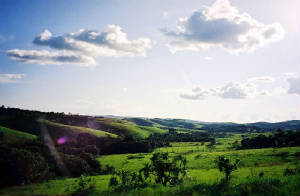|
| Colines du Gabon |

|
By J. Michael Fay and Photographs by Michael Nichols
In Gabon, where Mike Fay's epic walk across central Africa ended four years ago, a brand-new park is up and running. Fay
and photographer Michael Nichols return to the continent's great unspoiled coastline.
Get a taste of what awaits you in print from this compelling excerpt.
By rights this should have been a good night for leatherbacks, with a waning moon and the tide incoming, but by the time
we reached the stick marking the three-mile (four-kilometer) limit of the study beach, we hadn't found a single one. So we
had a bit of a snooze on the moist sand, then headed back down the beach. By now I'd gone from my trance to doing incantations
to see a turtle.
When we were about half a mile (one kilometer) from our starting point, an ominous black thing loomed ahead of us like
an apparition in a horror movie. A leatherback! She was head-to-land about 20 feet (6 meters) above the tide line on a nice
wide patch of beach. Clement instructed us to stand back while he checked how far along she was in the nesting process. "She's
dug the egg chamber," he whispered. Just behind her was a perfectly cylindrical hole about six inches (15 centimeters)
in diameter and a foot (30 centimeters) deep. "Sit quiet for a minute until she lays, then we can approach, no problem."
I heard the turtle make what sounded like a gasp, and Clement was up in a flash. Huddling up behind her, the low beam
from his headlamp defining the chamber, we could see that she'd dropped several eggs. Clement looked distressed. "The
hole isn't nearly deep enough," he said, pointing to the turtle's back right flipper, most of which was missing. The
loss must have handicapped her ability to excavate, a task that calls for all her strength and dexterity.
I watched spellbound. This old girl was pushing hard, and she already looked exhausted. Bloop more eggs fell. They were
the size of billiard balls, round and white. Every time mom pushed, out came eggs, up to four at once, covered with a gooey
mucus. As the hole filled, we counted: 30, 50, 80, and, finally, 84 eggs. Clement was right—the egg mass overflowed
the hole.
As soon as she'd finished, the turtle team hopped into action to record her vital statistics. Her carapace was measured:
143 centimeters (56 inches) long and 105 centimeters (41 inches) wide. Clement estimated her weight at 300 kilograms (660
pounds), suggesting she was no more than 20 years old. (Leatherbacks, which range widely in the open ocean, feeding on jellyfish,
their staple food, can reach more than a ton and live 50 years.) Loading a stainless steel ID tag into his pliers, Clement
grabbed the skin between the carapace and the damaged flipper and squeezed hard. She didn't even flinch. The turtle was duly
christened ASF2637, according to the tag number. Because tags sometimes fall off, Feree then applied a second one to the opposite
flipper. Seemingly oblivious to all this activity, the turtle started covering the eggs by alternately scooping sand over
the pile with one hind flipper and tamping it down with the top side of the other.
I glanced at Clement questioningly. He nodded. I touched her flipper, and my heart stopped when she almost grabbed my
wrist with it;that flipper seemed prehensile! I'd expected the limb to be hard and scaly, but it was fleshy and supple as
a seal's. The baby-soft skin was slate gray, with what looked like sponged-on blotches of white latex. Diligently, she continued
sweeping and tamping, working with such eerie dexterity that she struck me not as a turtle at all but as a person dressed
up in turtle costume. Any second now she would start talking: "Hey Mike, can you push that egg into the hole for me?"
I thought about all the things she must have seen in her decades at sea: giant passenger ships, trawler nets, sharks,
manta rays, humpback whales, oil spills, and tons of garbage. Where had she been, and what had injured her flipper?
She finished tamping, but two eggs remained exposed. Clement grabbed them and removed them far from the nest, lest they
alert predators like civets, ghost crabs, or monitor lizards to the nest's location. The covered eggs would incubate, unattended,
for 60 to 70 days. The hatchlings would break through the nest chamber at night and head for the water. Crabs would be lurking
on the beach, and for the tiny turtles that made it to the sea, jacks and mackerel, not to mention trawler nets, would be
waiting.
Get the whole story in the pages of National Geographic magazine.
|
